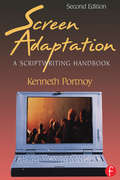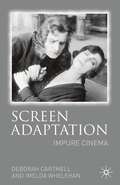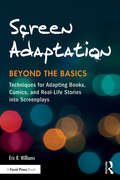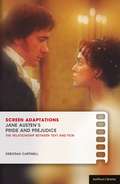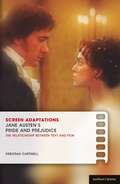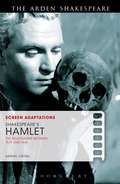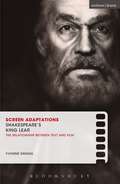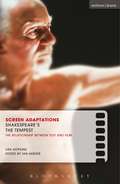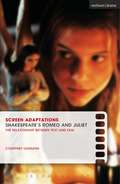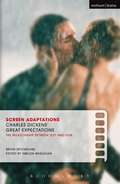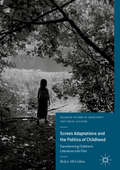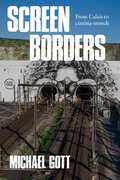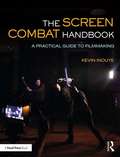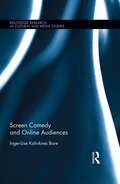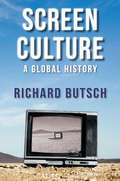- Table View
- List View
Screen Adaptation: A Scriptwriting Handbook
by Kenneth PortnoyScreen Adaptation : A Scriptwriting Handbook, 2nd ed. examines the challenge screenwriters face when adapting novels, plays, and short stories for the screen. Thoroughly updated to include new exercises and example from current films, this book provides practical, usable information on how to find the best plot line for a script, choose key characters, and understand the goals and formats of different genres. Topics include: determining which characters and events are most valuable on developing the main story;expanding short novellas and condensing long novels;using dialog to advance the story and reveal character;comparing the formats of plays, short stories, and novels to those of screenplaysapproaching the marketplaceIn this book, both beginning writers and professionals will find the tools necessary to evaluate a prospective source and create a successful screenplay
Screen Adaptation: A Scriptwriting Handbook
by Kenneth PortnoyScreen Adaptation : A Scriptwriting Handbook, 2nd ed. examines the challenge screenwriters face when adapting novels, plays, and short stories for the screen. Thoroughly updated to include new exercises and example from current films, this book provides practical, usable information on how to find the best plot line for a script, choose key characters, and understand the goals and formats of different genres. Topics include: determining which characters and events are most valuable on developing the main story;expanding short novellas and condensing long novels;using dialog to advance the story and reveal character;comparing the formats of plays, short stories, and novels to those of screenplaysapproaching the marketplaceIn this book, both beginning writers and professionals will find the tools necessary to evaluate a prospective source and create a successful screenplay
Screen Adaptation: Impure Cinema
by Imelda Whelehan Hester BradleyAdaptation studies has historically been neglected in both the English and Film Studies curricula. Reflecting on this, Screen Adaptation celebrates its emergence in the late 20th and 21st centuries and explores the varieties of methodologies and debates within the field. Drawing on approaches from genre studies to transtexuality to cultural materialism, the book examines adaptations of both popular and canonical writers, including William Shakespeare, Jane Austen and J.K.Rowling.Original and provocative, this book will spark new thinking and research in the field of adaptation studies. Mapping the way in which this exciting field has emerged and shifted over the last two decades, the book is also essential reading for students of English Literature and Film.
Screen Adaptation: Techniques for Adapting Books, Comics and Real-Life Stories into Screenplays
by Eric R. WilliamsOnce you understand the basics of screenwriting, ideas for your next screenplay are everywhere. Whether it comes from a favorite children’s book, a summer novel you discover accidentally, a news story that catches your imagination, or a chapter from your own life — advanced screenwriting strategies should now guide you through your first adaptation. In Screen Adaptation: Beyond the Basics, award-winning screenwriter Eric Williams uses examples from award-winning screenplays to explain new storytelling techniques. His real-world examples illustrate a range of advanced approaches — including new ways to identify and craft tension, how to reimagine structure and character, and how to strengthen emotional depth in your characters and in the audience. Screen Adaptation: Beyond the Basics teaches readers new ways to engage with source material in order to make successful adaptation decisions, regardless of the source material. The book offers: Three detailed examples of award-winning adaptations by the author, including the complete short story and final scripts used in the Voices From the Heartland project; Breakout boxes highlighting modern and historical adaptations and providing examples for each concept discussed in the book; More than fifty charts providing easy-to-use visual representations of complex concepts; New screenwriting techniques developed by the author, including the Triangle of Knowledge, the Storyteller’s Parallax, and the idea of Super Genres as part of a Screenwriters Taxonomy.
Screen Adaptation: Techniques for Adapting Books, Comics and Real-Life Stories into Screenplays
by Eric R. WilliamsOnce you understand the basics of screenwriting, ideas for your next screenplay are everywhere. Whether it comes from a favorite children’s book, a summer novel you discover accidentally, a news story that catches your imagination, or a chapter from your own life — advanced screenwriting strategies should now guide you through your first adaptation. In Screen Adaptation: Beyond the Basics, award-winning screenwriter Eric Williams uses examples from award-winning screenplays to explain new storytelling techniques. His real-world examples illustrate a range of advanced approaches — including new ways to identify and craft tension, how to reimagine structure and character, and how to strengthen emotional depth in your characters and in the audience. Screen Adaptation: Beyond the Basics teaches readers new ways to engage with source material in order to make successful adaptation decisions, regardless of the source material. The book offers: Three detailed examples of award-winning adaptations by the author, including the complete short story and final scripts used in the Voices From the Heartland project; Breakout boxes highlighting modern and historical adaptations and providing examples for each concept discussed in the book; More than fifty charts providing easy-to-use visual representations of complex concepts; New screenwriting techniques developed by the author, including the Triangle of Knowledge, the Storyteller’s Parallax, and the idea of Super Genres as part of a Screenwriters Taxonomy.
Screen Adaptations: A close study of the relationship between text and film (Screen Adaptations)
by Deborah CartmellThe study of literature on screen is a growing area of study in schools and universities. Many students have to produce critical essays comparing the novel and film versions of a particular text. The Screen Adaptations series offers a wealth of study material: from the literary context of the original work, through to thought-provoking comparisons of the screen versions, critical commentary and the afterlife of the films.Pride and Prejudice is a classic piece of literature and any new adaptation is a major event. With several well-known TV and film versions available (featuring stars such as Keira Knightley) as well as a Bollywood version, discussions around how these films interpret the story, themes and characters is a popular classroom choice for students and teachers alike. This new title in the Screen Adaptations series, provides a rich source of material to help students understand and write about the reciprocal relationship between film and literature. It offers in-depth analysis of the various screen versions and alternative `readings' as well as critical insight and an interview with writer Andrew Davies, best known for his 1995 BBC adaptation. Following from Shakespeare, Jane Austen on screen is now an established part of literary studies and the volume will conclude with a survey of the growing body of literature in the field.
Screen Adaptations: A close study of the relationship between text and film (Screen Adaptations)
by Deborah CartmellThe study of literature on screen is a growing area of study in schools and universities. Many students have to produce critical essays comparing the novel and film versions of a particular text. The Screen Adaptations series offers a wealth of study material: from the literary context of the original work, through to thought-provoking comparisons of the screen versions, critical commentary and the afterlife of the films.Pride and Prejudice is a classic piece of literature and any new adaptation is a major event. With several well-known TV and film version available (featuring stars such as Keira Knightley) as well as a Bollywood version, discussions around how these films interpret the story, themes and characters is a popular classroom choice for students and teachers alike. This new title in the Screen Adaptations series, provides a rich source of material to help students understand and write about the reciprocal relationship between film and literature. It offers in-depth analysis of the various screen versions and alternative `readings' as well as critical insight and an interview with writer Andrew Davies, best known for his 1995 BBC adaptation. Following from Shakespeare, Jane Austen on screen is now an established part of literary studies and the volume will conclude with a survey of the growing body of literature in the field.
Screen Adaptations: The Relationship between Text and Film (Screen Adaptations)
by Samuel CrowlHamlet is the most often produced play in the western literary canon, and a fertile global source for film adaptation. Samuel Crowl, a noted scholar of Shakespeare on film, unpacks the process of adapting from text to screen through concentrating on two sharply contrasting film versions of Hamlet by Laurence Olivier (1948) and Kenneth Branagh (1996). The films' socio-political contexts are explored, and the importance of their screenplay, film score, setting, cinematography and editing examined. Offering an analysis of two of the most important figures in the history of film adaptations of Shakespeare, this study seeks to understand a variety of cinematic approaches to translating Shakespeare's "words, words, words†? into film's particular grammar and rhetoric
Screen Adaptations: The Relationship between Text and Film (Screen Adaptations)
by Samuel CrowlHamlet is the most often produced play in the western literary canon, and a fertile global source for film adaptation. Samuel Crowl, a noted scholar of Shakespeare on film, unpacks the process of adapting from text to screen through concentrating on two sharply contrasting film versions of Hamlet by Laurence Olivier (1948) and Kenneth Branagh (1996). The films' socio-political contexts are explored, and the importance of their screenplay, film score, setting, cinematography and editing examined. Offering an analysis of two of the most important figures in the history of film adaptations of Shakespeare, this study seeks to understand a variety of cinematic approaches to translating Shakespeare's “words, words, words” into film's particular grammar and rhetoric
Screen Adaptations: A close study of the relationship between text and film (Screen Adaptations)
by Yvonne GriggsThis close study of film adaptations of King Lear looks atseveral different versions (mainstream, art-house and cinematic`offshoots') and discusses: the literary text in its historicalcontext, key themes and dominant readings of the text, how the text isadapted for screen and how adaptations have changed our reading of theoriginal text. There are many references to the literary text and screenplays andthe book also features quotations from directors and critics. There isplenty of discursive material here to support student work on both filmand literature courses.
Screen Adaptations: A close study of the relationship between text and film (Screen Adaptations)
by Yvonne GriggsThis close study of film adaptations of King Lear looks atseveral different versions (mainstream, art-house and cinematic`offshoots') and discusses: the literary text in its historicalcontext, key themes and dominant readings of the text, how the text isadapted for screen and how adaptations have changed our reading of theoriginal text. There are many references to the literary text and screenplays andthe book also features quotations from directors and critics. There isplenty of discursive material here to support student work on both filmand literature courses.
Screen Adaptations: A close study of the relationship between text and film (Screen Adaptations)
by Lisa HopkinsLiterature and film studies students will find plenty of materialto support their courses and essay writing on how the film versionsprovide different readings of the original text.Focussing on numerous film versions, from Percy Stow's 1908 adaptation to Peter Greenaway's Prospero's Books,the book discusses: the literary text in its historical context, keythemes and dominant readings of the text, how the text is adapted forscreen and how adaptations have changed our reading of the originaltext. There are numerous excerpts from the literary text, screenplaysand shooting scripts, with suggestions for comparison. The book alsofeatures quotations from authors, screenwriters, directors, critics andothers linked with the chosen film and text.
Screen Adaptations: A close study of the relationship between text and film (Screen Adaptations)
by Lisa HopkinsLiterature and film studies students will find plenty of materialto support their courses and essay writing on how the film versionsprovide different readings of the original text.Focussing on numerous film versions, from Percy Stow's 1908 adaptation to Peter Greenaway's Prospero's Books,the book discusses: the literary text in its historical context, keythemes and dominant readings of the text, how the text is adapted forscreen and how adaptations have changed our reading of the originaltext. There are numerous excerpts from the literary text, screenplaysand shooting scripts, with suggestions for comparison. The book alsofeatures quotations from authors, screenwriters, directors, critics andothers linked with the chosen film and text.
Screen Adaptations: A close study of the relationship between text and film (Screen Adaptations)
by Courtney LehmannThe Screen Adaptations series provides an in-depth look at how classic pieces of literature have been adapted for screen. It assesses the ways in which alternative screen interpretations offer up different readings of the original text as well as the methodologies and approaches of filmmakers. Each title in the series collects together a vast array of study material, critical insight and thought-provoking comparisons - from literary context to the afterlife of the screen versions. Shakespeare on Film is a huge area of study and Romeo and Juliet is one of his most popular plays with many teachers using film versions as a way of approaching the text. Focussing in the main on West Side Story and Baz Lurhmann's Shakespeare's Romeo & Juliet, this is a unique and comprehensive insight into the adaptation process providing a vital study aid for students.
Screen Adaptations: A close study of the relationship between text and film (Screen Adaptations)
by Courtney LehmannThe Screen Adaptations series provides an in-depth look at how classic pieces of literature have been adapted for screen. It assesses the ways in which alternative screen interpretations offer up different readings of the original text as well as the methodologies and approaches of filmmakers. Each title in the series collects together a vast array of study material, critical insight and thought-provoking comparisons - from literary context to the afterlife of the screen versions. Shakespeare on Film is a huge area of study and Romeo and Juliet one of his most popular plays with many teachers using film versions as a way of approaching the text. Focussing in the main on West Side Story and Baz Lurhmann's Shakespeare's Romeo & Juliet, this is a unique and comprehensive insight into the adaptation process providing a vital study aid for students.
Screen Adaptations: A close study of the relationship between text and film (Screen Adaptations)
by Brian McFarlaneA close study of the relationship between text and film versions of Great Expectations.Literature and film studies students will find plenty of material tosupport their courses and essay writing on how the film versionsprovide different readings of the original text.Focussing on David Lean's film of Great Expectations, thebook discusses: the literary text in its historical context, key themesand dominant readings of the text, how the text is adapted for screenand how adaptations have changed our reading of the original text.There are numerous excerpts from the literary text, screenplays andshooting scripts, with suggestions for comparison. The book alsofeatures quotations from authors, screenwriters, directors, critics andothers linked with the chosen film and text.
Screen Adaptations: A close study of the relationship between text and film (Screen Adaptations)
by Brian McFarlaneA close study of the relationship between text and film versions of Great Expectations.Literature and film studies students will find plenty of material tosupport their courses and essay writing on how the film versionsprovide different readings of the original text.Focussing on David Lean's film of Great Expectations, thebook discusses: the literary text in its historical context, key themesand dominant readings of the text, how the text is adapted for screenand how adaptations have changed our reading of the original text.There are numerous excerpts from the literary text, screenplays andshooting scripts, with suggestions for comparison. The book alsofeatures quotations from authors, screenwriters, directors, critics andothers linked with the chosen film and text.
Screen Adaptations and the Politics of Childhood: Transforming Children's Literature into Film (Palgrave Studies in Adaptation and Visual Culture)
by Robyn McCallumThis book features a cutting edge approach to the study of film adaptations of literature for children and young people, and the narratives about childhood those adaptations enact. Historically, film media has always had a partiality for the adaptation of ‘classic’ literary texts for children. As economic and cultural commodities, McCallum points out how such screen adaptations play a crucial role in the cultural reproduction and transformation of childhood and youth, and indeed are a rich resource for the examination of changing cultural values and ideologies, particularly around contested narratives of childhood. The chapters examine various representations of childhood: as shifting states of innocence and wildness, liminality, marginalisation and invisibility. The book focuses on a range of literary and film genres, from ‘classic’ texts, to experimental, carnivalesque, magical realist, and cross-cultural texts.
Screen borders: From Calais to <i>cinéma-monde</i>
by Michael GottFilm and television offer important insights into social outlooks on borders in France and Europe more generally. This book undertakes a visual cultural history of contemporary borders through a film and television tour. It traces on-screen borders from the Gare du Nord train station in Paris to Calais, London, Lampedusa and Lapland. It contends that different types of mobilities and immobilities (refugees, urban commuters, workers in a post-industrial landscape) and vantage points (from borderland forests, ports, train stations, airports, refugee centers) are all part of a complex French and European border narrative. It covers a wide range of examples, from popular films and TV series to auteur fiction and documentaries by well-known directors from across Europe and beyond.
Screen borders: From Calais to <i>cinéma-monde</i>
by Michael GottFilm and television offer important insights into social outlooks on borders in France and Europe more generally. This book undertakes a visual cultural history of contemporary borders through a film and television tour. It traces on-screen borders from the Gare du Nord train station in Paris to Calais, London, Lampedusa and Lapland. It contends that different types of mobilities and immobilities (refugees, urban commuters, workers in a post-industrial landscape) and vantage points (from borderland forests, ports, train stations, airports, refugee centers) are all part of a complex French and European border narrative. It covers a wide range of examples, from popular films and TV series to auteur fiction and documentaries by well-known directors from across Europe and beyond.
The Screen Combat Handbook: A Practical Guide for Filmmakers
by Kevin InouyeThe Screen Combat Handbook is an essential guide to navigating the unique challenges of putting combat on screen. Explore the process from the early stages of preproduction planning all the way through to editing and sound design, and everything in-between. This book uses practical instruction, examples, interviews, and illustrations to show how to plan, shoot, and assemble safe and effective fight sequences. It includes sections on thoughtful and practical design choices in set, wardrobe, props, and effects, preproduction planning, on-set protocol, fight choreography and coordination, shot planning and technical tricks, acting choices, effective cinematography, and impactful editing and sound design. It provides an invaluable resource for all those involved including directors, fight coordinators, actors and stunt players, and any filmmaker attempting to shoot an exciting action scene safely. Whether working on a no-budget indie production or on a professional set, this is your ultimate guide to screen combat and fight choreography.
The Screen Combat Handbook: A Practical Guide for Filmmakers
by Kevin InouyeThe Screen Combat Handbook is an essential guide to navigating the unique challenges of putting combat on screen. Explore the process from the early stages of preproduction planning all the way through to editing and sound design, and everything in-between. This book uses practical instruction, examples, interviews, and illustrations to show how to plan, shoot, and assemble safe and effective fight sequences. It includes sections on thoughtful and practical design choices in set, wardrobe, props, and effects, preproduction planning, on-set protocol, fight choreography and coordination, shot planning and technical tricks, acting choices, effective cinematography, and impactful editing and sound design. It provides an invaluable resource for all those involved including directors, fight coordinators, actors and stunt players, and any filmmaker attempting to shoot an exciting action scene safely. Whether working on a no-budget indie production or on a professional set, this is your ultimate guide to screen combat and fight choreography.
Screen Comedy and Online Audiences (Routledge Research in Cultural and Media Studies)
by Inger-Lise Kalviknes BoreThe question of why we laugh (or don't laugh) has intrigued scholars since antiquity. This book contributes to that debate by exploring how we evaluate screen comedy. What kinds of criteria do we use to judge films and TV shows that are meant to be funny? And what might that have to do with our social and cultural backgrounds, or with wider cultural ideas about film, TV, comedy, quality and entertainment? The book examines these questions through a study of audience responses posted to online facilities such as Twitter, Facebook, review sites, blogs and message boards. Bore’s analysis of these responses considers a broad range of issues, including how audiences perceive the idea of "national" comedy; what they think of female comedians; how they evaluate romcoms, sitcoms and web comedy; what they think is acceptable to joke about; what comedy fans get excited about; how fans interact with star comedians; and what comedy viewers really despise. The book demonstrates some of the ways in which we can adapt theories of humour and comedy to examine the practices of contemporary screen audiences, while offering new insights into how they negotiate the opportunities and constrictions of different online facilities to share their views and experiences.
Screen Comedy and Online Audiences (Routledge Research in Cultural and Media Studies)
by Inger-Lise Kalviknes BoreThe question of why we laugh (or don't laugh) has intrigued scholars since antiquity. This book contributes to that debate by exploring how we evaluate screen comedy. What kinds of criteria do we use to judge films and TV shows that are meant to be funny? And what might that have to do with our social and cultural backgrounds, or with wider cultural ideas about film, TV, comedy, quality and entertainment? The book examines these questions through a study of audience responses posted to online facilities such as Twitter, Facebook, review sites, blogs and message boards. Bore’s analysis of these responses considers a broad range of issues, including how audiences perceive the idea of "national" comedy; what they think of female comedians; how they evaluate romcoms, sitcoms and web comedy; what they think is acceptable to joke about; what comedy fans get excited about; how fans interact with star comedians; and what comedy viewers really despise. The book demonstrates some of the ways in which we can adapt theories of humour and comedy to examine the practices of contemporary screen audiences, while offering new insights into how they negotiate the opportunities and constrictions of different online facilities to share their views and experiences.
Screen Culture: A Global History (New Directions in Media History)
by Richard ButschIn this expansive historical synthesis, Richard Butsch integrates social, economic, and political history to offer a comprehensive and cohesive examination of screen media and screen culture globally – from film and television to computers and smart phones – as they have evolved through the twentieth and twenty-first centuries. Drawing on an enormous trove of research on the USA, Britain, France, Egypt, West Africa, India, China, and other nations, Butsch tells the stories of how media have developed in these nations and what global forces linked them. He assesses the global ebb and flow of media hegemony and the cultural differences in audiences' use of media. Comparisons across time and space reveal two linked developments: the rise and fall of American cultural hegemony, and the consistency among audiences from different countries in the way they incorporate screen entertainments into their own cultures. Screen Culture offers a masterful, integrated global history that invites media scholars to see this landscape in a new light. Deeply engaging, the book is also suitable for students and interested general readers.
